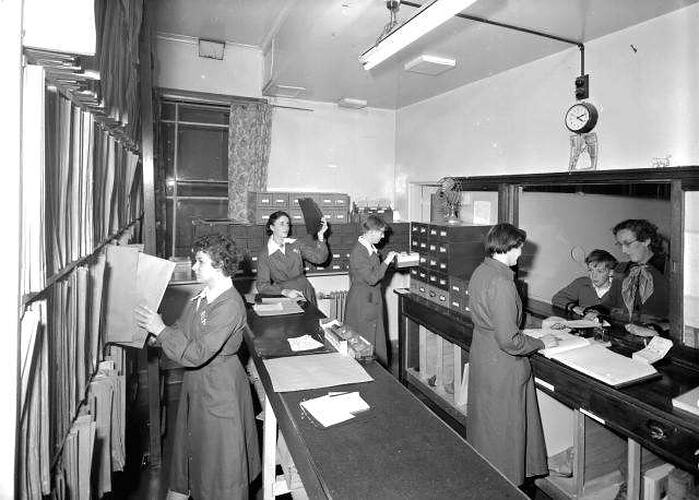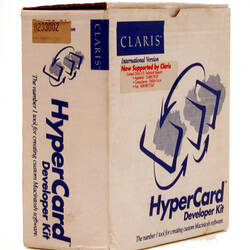HyperCard is a software program that can be used to author an application of the user's design. At the time of introduction, it was a software application in a genre all of its own. Apple described it as a hypermedia program or construction kit. The metaphor of a meccano kit was used. It was written by Bill Atkinson and released with the System 6 Macintosh operating system.
HyperCard is difficult to explain; it is not a paint program, but you can paint with it; it is not a draw program but you can draw in it; it is not a word processor but you can type in it; it is not an animation program but you can construct animations with it; it is not a database, but you can use it to construct a database; it is not a presentation program, but you can develop a presentation with it; it is not a calculator but you can get it to make calculations and be a calculator; it is not a simulator, but you can simulate physical entities such as electronic circuits!
With a database, the relevant metaphor is a filing cabinet with files called 'records' that contain data such as pictures or text. With HyperCard, the relevant metaphor is a stack of cards, similar to a card index, in which each card contains information as pictures or text. The user can move from card to card sequentially or from one card to any other card in the stack and one stack can be linked with another stack. This freedom of movement through data is similar to what we now experience in moving around the internet.
HyperCard supports its own powerful programming language called HyperTalk whose command lines are written in an English-like language. HyperTalk can be used to manipulate data and the user interface. The HyperTalk programming language was created in 1986-87 by Dan Winkler.
Many freeware stacks were circulated that performed a wide variety of functions. An address book was just one of these. Stacks could be modified by the user to suit the needs of the user. Some HyperCard stacks were developed as commercial enterprises. One of these was Reports For HyperCard which was designed to add reporting functionality to databases. Myst, one of the best-selling computer-games ever, was initially released as a HyperCard stack.
In Melbourne, HyperCard was used extensively in education. Examples include:
. a stack of multiple choice test questions
. assembling, storing and delivering teaching materials that included graphs from Excel
. making class KeyNote-like presentations and handouts for students
. a calculator that included a variety of mathematical functions and graphing capabilities
. computer aided instruction in the sciences incorporating animation and sound
. fractals
. Geographical Information System tutorial
. oil-spill modelling
. literacy development
. road safety
. a database front-end to an Oracle database
. a database in toxicology
. selecting and playing tracks on a videodisk
. an interactive educational presentation showing jobs in the wool industry
. educational interactive games 'Flowers of Crystal' and 'Granny's Garden'
. 'Beach Trails' - exploring the local sea shore and shells.
. TTAPS ('Touch Typing - a Program for Schools').
Most of these developments were undertaken by persons who were not professional programmers, but who were school teachers or university lecturers.
The legacy of HyperCard in computing is enormous.
1. HyperCard influenced the development of many scripting languages
HyperTalk spawned other scripting languages, especially AppleScript, the main scripting language of Apple's Mac OS, and Lingo, the programming language of Macromedia Director. It has even been claimed to be an ancestor of Microsoft's Visual Basic for the Windows OS.
2. HyperCard was one of the first products to introduce the concept of Hypertext
Later versions of HyperCard supported HTML-style text hyperlinks
3. HyperCard inspired the creation of HTTP and JavaScript
HyperCard influenced Robert Cailliau, who was closely involved in the development of HTTP (HyperText Transfer Protocol) and JavaScript, both key elements in the World Wide Web.
4. HyperCard influenced the functionality of web browsers
Pei-Yuan Wei, the author of ViolaWWW, one of the earliest web browsers (first released in 1991), used his knowledge of HyperCard in the development of his web browser. He took the hyperlink concept from HyperCard and implemented it (not on a Macintosh) in ViolaWWW, thus making hyperlinking global through the Web as opposed to local through HyperCard stacks on a Macintosh.
5. HyperCard introduced the pointing finger cursor
The pointing finger cursor now used by Web browsers as the hyperlink cursor, first made its appearance in HyperCard as a stack navigator!
6. HyperCard spawned HyperCard-like programs which have survived
SuperCard and Revolution have survived as current day (2007) programs with extended HyperCard-like functionality.
7. HyperCard influenced the development of Wikipedia
The creator of Wikipedia has acknowledged that the concepts behind Wikis can be traced back to the concepts in HyperCard.
8. HyperCard underpinned Myst
As noted above, HyperCard was the program in which Myst was first developed, Myst being one of the best selling computer games ever.
HyperCard was developed by Bill Atkinson and gifted to Apple on the basis that Apple would release it for free use on all Macintoshes. It was initially released in August 1987. It immediately became a huge success and was used in many ways by many people, many of whom began programming for the first time. It was not until 1989 (WinPlus) and 1990 (ToolBook) that roughly equivalent programs emerged on the Windows platform.
Although the philosophy behind HyperCard was very much in line with the Apple philosophy of empowerment at an affordable cost, the fact that HyperCard was free and did not generate profits resulted in difficulty in Apple allocating adequate resources for its further development. So although it achieved considerable popularity in the late 1980s, the lack of significant further development by Apple resulted in developments by other corporations taking over the functionality and niche role that HyperCard had so successfully established for itself. The incorporation of colour was a particular issue; it was achieved belatedly in a totally inadequate form. HyperCard was finally abandoned by Apple in 2004.
References:
For more information see HyperCard and HyperText on Wikipedia, from which some of the information in this description has been sourced.
http://en.wikipedia.org/wiki/Hypertext
http://en.wikipedia.org/wiki/HyperCard
More Information
-
Keywords
-
Authors
-
Article types

